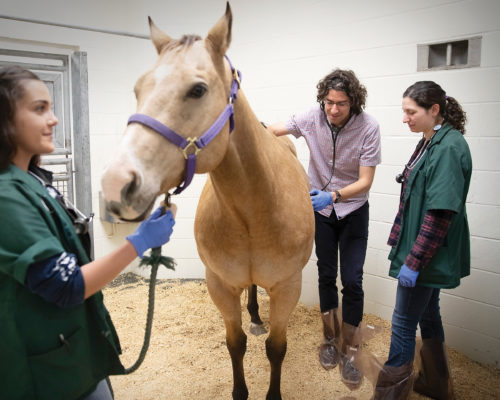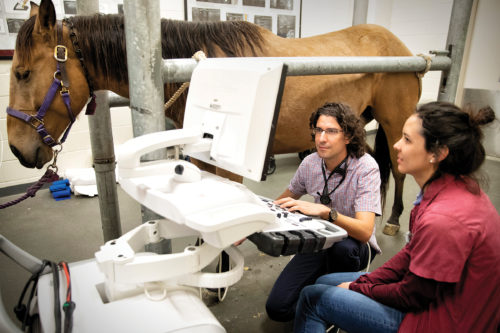A Vision of the Future
By incorporating technology into his clinical, research, and teaching efforts, Dr. Cristobal Navas works to expand both future and current veterinarians’ understanding of issues related to equine internal medicine and education.
Story by Dr. Megan Palsa

Dr. Cristobal Navas is a clinical assistant professor in equine internal medicine and ultrasound at the Texas A&M University Large Animal Hospital (LAH) in the College of Veterinary Medicine & Biomedical Sciences’ (CVM) Veterinary Medical Teaching Hospital (VMTH).
TEXAS BOUND
Navas attended veterinary school in Valencia, Spain, and worked in private practice for approximately three years before he came to the United States, where he completed an internship at Virginia Tech, an internal medicine residency at the University of Illinois, and a fellowship in cardiology and ultrasound at the University of Pennsylvania.
After spending three years lecturing at the University of Pennsylvania and Washington State University, he moved to Switzerland. While working at the University of Bern, he saw a posting for a position at Texas A&M in internal medicine, with a focus on ultrasonography.
Lucky for Texas A&M, three years ago, he accepted the position and transferred from Switzerland to Texas for what we like to say is his final stop.
Navas’ wife joined him on his journey back to the states. They now have two daughters, 2-year-old Isabel and newborn Clara.
NAVAS AT WORK
Navas has a clinical appointment, which means that the bulk of his work is in the clinic, where he mainly sees horses with internal medicine problems, including those in the lungs, gastrointestinal tract, heart, and neurological disorders. He also performs ultrasounds on horses and food animals.
Even though that sounds like a lot of work, that’s not Navas’ only job—the other two parts are teaching and research.

“I teach in areas that are related to my areas of expertise—large animal internal medicine but, more specifically, equine cardiology and ultrasound,” Navas said. “Because of time commitments, all of my research is clinically oriented, meaning I try to solve the problems that we come across in the clinic on a day-to-day basis.”
While Navas has several ongoing research projects on various topics, because his main interest is cardiology and ultrasound, most are associated with those areas.
For example, with one of A&M’s residents, Kari Bevevino, he is working on a project looking at the wall of the intestinal tract using very high frequency probes to see the different layers of the tract and to determine how that can help doctors be more precise when diagnosing gastrointestinal illnesses (GI).
With student Michael Manriquez, Navas is trying different devices to record horses’ heart rhythms to better understand one of the serious problems within the equine industry—equine sudden death during exercise.
“We need better and more user-friendly devices to perform large-scale studies that can solve this problem, which affects not only horses’ health but also riders’ safety and the public perception of welfare during equestrian sports,” Navas said.
Lately, Navas also has been working on other research projects, some of which are not necessarily traditional topics for an internist, that focus on scholarship, teaching and learning, and telehealth.
RESEARCH AND TEACHING

In one of those, Navas and other CVM faculty members have been working to collect empirical evidence for teaching techniques being incorporated into the Doctor of Veterinary Medicine (DVM) program.
“Traditionally, as educators, we have said, ‘We are experts in our fields; therefore, we should be able to teach people,’” Navas said. “This teaching based on common sense seems to give good results but is not based on evidence. We’re examining if we can make better decisions by finding this evidence.”
The teaching team—led by Dr. Kristen Chaney, a clinical assistant professor in the CVM, and Navas—designed a study to prove their hypothesis that interactive digital materials are more effective than traditional textbook learning. They found that students, indeed, seem to get better ultrasound images after doing interactive activities versus reading textbooks.
The experimental part of that study was completed early in 2018. The data was analyzed by the team, which, in addition to Chaney and Navas, included Drs. Lindsey Gilmore, a radiologist, and Ashley Watts, an equine surgeon.
With the data in hand, they have now designed a similar project that will compare similar interactive materials to a traditional classroom lecture.
Finally, Navas and his team have two projects using telemedicine. They are working with three Texas practices, in Austin, Lamesa, and Waller. For the project, they connected each practice’s ultrasound machines to the internet.
“We can see the screen of their ultrasound machine, the horse, and their hand using the webcam in their computer and Google glasses,” he said. “It’s not the same as being in the same room with the horse and the owner, which I believe is the best scenario, but this real-time collaboration can get close.

“We are learning that, first, the technology is feasible—it doesn’t matter if the horse is in Houston, in Austin, or in Lamesa; as long as they have a good internet connection, we can collaborate remotely,” he said. “Second, it can help on-site veterinarians manage cases. Sometimes the information can help the animal; in others, it just makes the owners happy to know that there is a second set of eyes looking at their horse. And, third, veterinarians tell us that they often learn new or different techniques.”
Navas emphasized that while all of the veterinarians they work with are extremely good at their jobs, through telemedicine, they have access to expertise of clinicians that have dedicated their careers to specific fields.
“One of the privileges of my job at A&M, and the strength of the VMTH, is that if I am dealing with a complex case, I can walk down the hallway and discuss it with world experts in many different fields,” he said. “Telemedicine can make this accessible to veterinarians worldwide. This may be part of the solution to the problem of limited access to veterinary or specialty care in remote areas of the state or the world.”
Navas loves teaching internal medicine courses to all levels of veterinary students, and especially courses that are associated with cardiology and ultrasound. He said that one thing that is good for a teaching hospital like the VMTH is that “many of the courses that we teach, we teach between different specialists.”
“In other words, we are a collaborative group of people from different areas and departments who are working together and lecturing with one another,” Navas said. “Whether it’s internal medicine, cardiology, neurology, radiology, etc., we’re working as one to teach and learn together.”
###
Note: This story originally appeared in the 2019 Spring edition of CVM Today.
For more information about the Texas A&M College of Veterinary Medicine & Biomedical Sciences, please visit our website at vetmed.tamu.edu or join us on Facebook, Instagram, and Twitter.
Contact Information: Jennifer Gauntt, Interim Director of Communications, Media & Public Relations, Texas A&M College of Veterinary Medicine & Biomedical Science; jgauntt@cvm.tamu.edu; 979-862-4216


